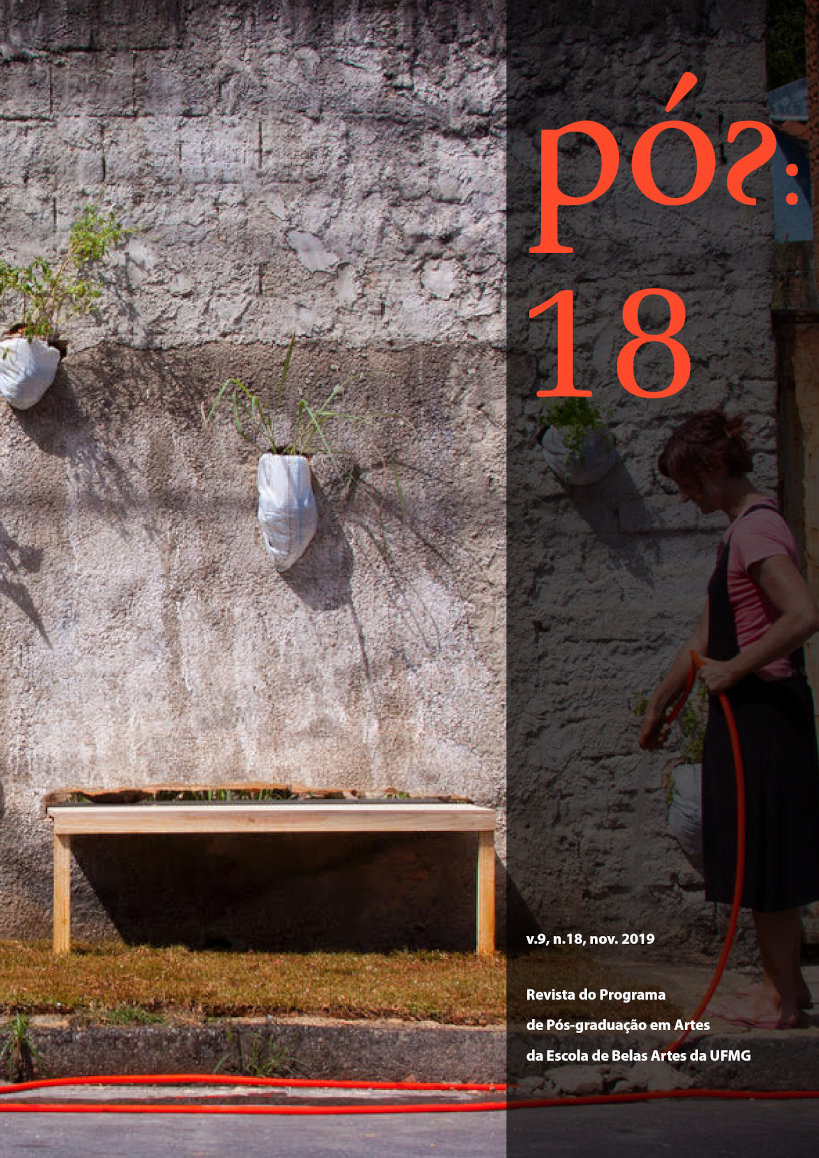Suspender o tempo e o espaço
O corpo visto sob a lente do conceito japonês de Ma
DOI:
https://doi.org/10.35699/2237-5864.2019.16126Palavras-chave:
Espaço ma, Corpo, Processo criativoResumo
Ma significa vazio, espaço, tempo ou pausa e sua origem está correlacionada às ideias de transitoriedade e incompletude, características da estética Zen-budista. Mais do que um conceito, ma é um modus operandi na vida cotidiana japonesa, que ilustra um intervalo de espaço-tempo disponível para a materialização de eventos em potencial, em que infinitas combinações sígnicas podem acontecer. Neste artigo, abordaremos a aplicação de ma enquanto princípio condutor da criação, bem como da apreciação de obras na área das artes do corpo. O corpo será tratado comum corpo-em-processo com total disponibilidade para a interação com outras mídias na produção de sentido.
Referências
AKAGI, M. Entrevista cedida a Paul McIness. Revista Metrópolis, 31 ago. 2018. Disponível em: https://metropolisjapan.com/akaji-maro-dairakudakan-interview/?gclid=Cj0KCQjwgOzdBRDlARIsAJ6_HNmmGe08op17sKMDmmUVNLsgJSFhdCUf2nUGb5LTJEtezXepwYO-eO4aAjHXEALw_wcB. Acesso em: 8 out. 2018.
BARBA, E. The Paper Canoe. Nova York: Routledge, 1995.
BARBA, E.; Savarese, N. A Dictionary of Theatre Anthropology. Nova York: Routledge, 2006.
FERRARA, L. Leitura sem palavras. São Paulo: Ática, 2002.
GREINER, C. Butô: pensamento em evolução. São Paulo: Escrituras, 1998.
GREINER, C. A arte de viver entre. In: Okano, M. Ma: entre-espaço da arte e comunicação no Japão. São Paulo: Annablume; Fapesp; Fundação Japão, 2012. Prefácio.
GRUBER, M. “Form und Wandlung. Schauspiel als Weg am Beispiel des Aikido und anderenArten der Körperarbeit”. In Schettgen, Peter org. Heilen statt Hauen. Aikido-Erweiterungen inTherapie und beruflicher Bildungsarbeit. Augsburg: 2002. p. 117-134.
HIJIKATA, T. Dançarina doente. In: HIJIKATA, T. Obras completas (Zenshû), t.I. Tóquio: Kawade Shobô Shinsha, 2005.
IBRI, I. A. Kósmos Noetós: A arquitetura metafísica de Charles S. Peirce. São Paulo: Paulus, 2015.
INADA, N. Hijikata Tatasumi: o corpo pós-morte (Em Japonês Hijikata Tatsumi Zetsugo no Shintai). Toquio: NHK Shuppan, 2008.
KALGREN, B. Analytic Dicitionary of Chinese and Sino-Japanese. Paris: Paul Geuthner, 1923.
KEENE, D. Japanese Aesthetics. Philosophy East and West, University of Hawaii Press, v. 19, n. 3, p. 293-306,1969.
KERCKHOVE, D. The skin of Culture. In: GENOSKO, G. (ed.) Marshall McLuhan: Critical evaluations in cultural theory. v. II. Londres: Routledge, 2019. p. 148-158.
KOMPARU, K. The Noh Theatre: Principles and Perpsectives. Nova York: Wheatherhill: 1983.
KUNICHI, U. Hijikata Tasumi: Pensar um corpo esgotado. Trad.: Greiner, C.; Filho, E. São Paulo: N-1 edições, 2018.
MANN, J. When Buddhists Attack. Vermont: Tuttle Publishing, 2012.
MASAKAZU, Y. On The Art of the Noh Drama: The major treatises of Zeami. Princeton: Princeton University Press, 1984.
MORIOKA, M. How to create Ma – The living pause. International Journal for Dialogical Science, v. 9, n. 1, p. 81-95, 2015.
NHAT HANH, T. Call me by My True Names – The Collected Poems of Thich Nhat Hanh. Berkeley: Parallax Press, 2005.
NITSCHKE, Gunter. MA: the Japanese sense of place in old and new architecture and planning. Tokyo: Architectural Design, 1966.
OKANO, M. MA: entre-espaço da arte e comunicação no Japão. São Paulo: Annablume; Fapesp: Fundação Japão, 2012.
OKANO, M. O espaço Ma e Hélio Oiticica. In: GREINER, Christine; FERNANDES, Ricardo Muniz. (org.). Tokyogaqui: Um Japão imaginado, São Paulo: SESC, 2008. p. 176-187.
OKOMURA, S. Lion’s Roar. Dharma Dictionary Kokoro. Disponível em: https://www.lionsroar.com/dharma-dictionary-kokoro/. Acesso em: 8 set. 2018.
PILGRIM, R. B. Intervals (Ma) in Space and Time: Foundations for a Religio-Aesthetic Paradigm in Japan”. In: WEI-HSUN FU, Charles; HEINE, Steven (ed.). Japan in traditional and postmodern perspectives. Nova York: State University of New York Press, 1995. p. 55-79.
RANDOM, M. La stratégie de l’invisible. Paris: Félin, 1985.
RICHIE, D. A Tractate on Japanese Aesthetics. Berkeley, CA: Stone Bridge Press, 2007.
SAMTEN, L. A Roda da Vida. São Paulo: Peirópolis, 2010.
SHIODA, G. Dynamic Aikido. Tokyo: Kodansha International, 1977.
SUZUKI, D.T. An introduction to Zen-Buddhism. Grove: New York, 1964.
SUZUKI, D.T. Zen and Japanese Culture. Princeton: U.P., 1959, 1973.
SUZUKI, D.T. Tôyôteki na mikata (A visão oriental). Tokyo: Shunju-sha, 1992.
SUZUKI, S. Mente Zen, Mente de Principiante. Trad. Odete Lara. São Paulo: Palas Athena, 1996.
VIALA, Jean; MASSON-SEKINE. Nourit. Butoh: shades of darkness. Tóquio: Shufunotomo co. Ltd., 1988.
WENDELL, E. Wilson. Mushin and Zanshin. 2010. Disponível em: <https://mineralogicalrecord.com/wilson/pdfs/Concepts--Mushin%20and%20Zanshin.pdf > Acesso em: 8 jun. 2019.
Wylie-Marques, K. Opening the Actor's Spiritual Heart: The Zen Influence on Noh Training and Performance. Journal of Dramatic Theory and Criticism, p. 131-160, 2003.
YUSA, M. Riken no Ken. Zeami's Theory of Acting and Theatrical Appreciation. Monumenta Nipponica. v. 42, n. 3, p. 331-345, Autumn, 1987.
Zeami, M. The Flowering Spirit. Trad.: William S. Wilson. Londres: Kodansha International, 2006.
Downloads
Publicado
Edição
Seção
Licença
Copyright (c) 2019 maria cristina Elias Meneghetti, Priscila Arantes

Este trabalho está licenciado sob uma licença Creative Commons Attribution-NonCommercial 4.0 International License.
Autores que publicam nesta revista concordam com os seguintes termos:
- Autores mantém os direitos autorais e concedem à revista o direito de primeira publicação, com o trabalho simultaneamente licenciado sob a Creative Commons Attribution-NonCommercial 4.0 International License que permite o compartilhamento do trabalho com reconhecimento da autoria e publicação inicial nesta revista.
- Autores têm autorização para assumir contratos adicionais separadamente, para distribuição não-exclusiva da versão do trabalho publicada nesta revista (ex.: publicar em repositório institucional ou como capítulo de livro), com reconhecimento de autoria e publicação inicial nesta revista.
- Autores têm permissão e são estimulados a publicar e distribuir seu trabalho online (ex.: em repositórios institucionais ou na sua página pessoal) a qualquer ponto antes ou durante o processo editorial, já que isso pode gerar alterações produtivas, bem como aumentar o impacto e a citação do trabalho publicado
- É responsabilidade dos autores a obtenção da permissão por escrito para usar em seus artigos materiais protegidos por lei de Direitos Autorais. A Revista PÓS não é responsável por quebras de direitos autorais feitas por seus colaboradores.












